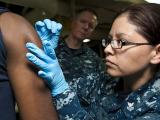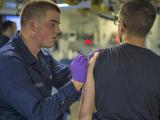May 1, 2003 (CIDRAP News) – Although few states have finished the first stage of their smallpox vaccination programs, half of the states that responded to a recent survey said they are prepared to vaccinate their entire population in 10 days if necessary.
The survey by the Association of State and Territorial Health Officials (ASTHO) drew responses from 33 states and New York City. Of those 34 jurisdictions, 17 said they could vaccinate all their people within 10 days if a smallpox outbreak somewhere in the world indicated a need. Fifteen states, or 45% of the total, said they were not prepared to do that, and two states didn't answer the question.
Five states reported having completed the first stage of the smallpox vaccination program, focusing on public health and hospital workers who volunteer to serve on smallpox response teams. Another 22 states, or 64%, said they were continuing to work on the first stage, and four reported they were taking a "programmatic pause." Three states said they have begun to expand their program beyond the first phase, but the survey findings didn't make clear whether they had achieved their goals for the first phase.
ASTHO President Mary Selecky, Washington State secretary of health, presented the survey findings today at a meeting of the Institute of Medicine's (IOM's)Committee on Smallpox Program Implementation in Washington, DC. The committee was established to advise the Centers for Disease Control and Prevention (CDC) on safety issues in the vaccination campaign. (The meeting was accessible through an audio webcast, and the survey results are posted on ASTHO's Web site.)
Selecky reported that only 10 of the 62 jurisdictions giving smallpox shots (states, territories, and several major cities) have vaccinated more than 1,000 people so far. Twenty of the 62 jurisdictions have vaccinated fewer than 100 people, and seven territories and the state of Nevada haven't vaccinated anyone. (The CDC reports a total of 33,444 people vaccinated as of Apr 18.)
In the survey, state health officials were asked what factors have limited their vaccination programs. Twenty-seven states cited liability issues, 20 cited the reports of myocarditis or pericarditis in a few vaccinees, and 24 listed the absence (until very recently) of a compensation program for people harmed by the vaccine. Another ten states listed the winding down of the war in Iraq, and seven mentioned the perceived lack of risk of a smallpox outbreak.
States were also asked which of several possible steps they are likely to take next to achieve smallpox preparedness. Twenty-one said they are likely to develop a list of qualified but as yet unvaccinated volunteers to be used to vaccinate the public if the need arose, and 13 said they expect to expand the vaccination effort to "the larger community of first responders."
Also at today's meeting, the president of the Council of State and Territorial Epidemiologists (CSTE) said the smallpox vaccination program has achieved considerable success, even though the number vaccinated to date is far below the original first-stage goal of up to 500,000. "The first success is that we are close to 34,000 people now who were vaccinated for smallpox. That's 34,000 more today compared to three months ago," said Ginafranco Pezzino, Kansas state epidemiologist, adding that the vaccinees are organized into teams.
"The other thing that I think is a very important success is that we've seen very very few of those traditional severe side effects [of vaccination], and this tells me that the screening process has worked," Pezzino said.
However, he said the beginning of the campaign back in January was too hurried. "The push for a quick start meant we didn't have enough time to convince some of the stakeholders in this process, and I think we're still paying for this," he said. Citing resistance from some hospitals and physicians, he added, "We didn't have enough time to convince those influential people it was the right thing to do."
In Kansas, Pezzino said, 23 counties have at least one smallpox response team, and they are positioned to serve more than 75% of the state's population. Only 15 volunteers were excluded from vaccination, which means that screening worked well, he said.
Pezzino questioned the national strategy of offering smallpox shots to all emergency response workers, including police and firefighters, in the second phase of the immunization program. That phase calls for vaccinating up to 10 million persons.
"It's still unclear to us [CSTE] why we need to target first responders as a high-risk group," he said. "Why are we doing that, where are the data that can support this from an epidemiologic point of view?" He said first-responders are less knowledgeable about medicine than health workers, and the communication and screening approaches will have to be different for them.
When a committee member asked Pezzino how many vaccinations are needed to achieve preparedness, he said he couldn't answer. "Even for my state today, I can't give you a good range of how many people need to be immunized, because that planning hasn't been done at the local level yet, because we're all so busy," he said.
Selecky presented some ASTHO recommendations to the IOM committee. "We need a national consensus on who should be asked to consider voluntary vaccination at this point in time, and why," she said. She also called for a "clear articulation of the best intelligence information" about the risk of a smallpox release, a clear explanation of all the liability and compensation protections now in place for the smallpox program, and sufficient funding for all public health preparedness programs.
See also:
ASTHO survey
http://www.gao.gov/new.items/d03578.pdf


















